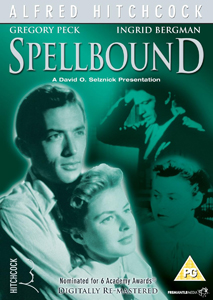Alfred Hitchcock’s seventh American feature, “Spellbound” (1945), is a fascinatingly successful crossroads film. It blends a sweeping score and romance like we might find in “Rebecca” (1940) with a mystery that’s so psychologically based that we can see the path toward “Vertigo” (1958).
Psychoanalysis was a burgeoning but largely mysterious field at the time. An opening crawl gives 1945 audiences the definition of psychoanalysis, and gives a prominent credit to the on-set adviser in the field. For today’s viewers, that crawl takes us back to the time when this was new stuff.
Notable in a more subtle way is that Constance Petersen (Ingrid Bergman) is the only female psychiatrist at the Vermont facility. Her male colleagues all respect her skills – even if one of them, Dr. Fleurot (John Emery), doesn’t respect her personal space. (She laughs it off in a 1940s way.) Indeed, Constance is so book smart that her colleagues chide her for her shortage of street smarts.

“Spellbound” (1945)
Director: Alfred Hitchcock
Writers: Ben Hecht (screenplay); John Palmer, Hilary Saint George Saunders (novel)
Stars: Ingrid Bergman, Gregory Peck, Michael Chekhov
A Constance presence
Interestingly, Ben Hecht’s screenplay (from the 1927 novel “The House of Dr. Edwardes” by John Palmer and Hilary Saint George Saunders) does a gender flip – compared to, say, the more traditional “Rebecca.” The appropriately named Constance is the steady presence and Gregory Peck’s character (an amnesiac who ultimately learns his name is John Ballantyne) is the unstable one in the budding romance.
It’s both giggle-worthy and grounded that Constance knows about the psychology of love from her studies but has never experienced it until meeting John. As the feeling of love overcomes her, she analyzes it. Knowledge allows us to understand emotions, but not necessarily to control them.
Despite her constancy, Bergman’s character is nonetheless softer than her more famous turn in “Notorious” (1946). In a controversial choice, I like “Spellbound” slightly more. Peck lets his tall stature project John’s strong side, then lets his naturally trembling lip portray his vulnerable side.
Even when he has brief bursts of anger – perhaps stemming from shell shock in World War II, another issue entering the mainstream at this time – Constance is immediately able to deal with it. She shows her love in part through her clinical skills.
Even if the amnesia and repressed memories are simplified for the sake of cinema, “Spellbound” is engrossing. Composer Miklós Rózsa deserves credit here, as he creates a wall of music similar to Franz Waxman’s in “Rebecca.” At the time, visual artist Salvador Dali’s dream sequence – when John goes into a hypnotized state to recall buried memories — was hyped up. It’s historically interesting and technically noteworthy, but a little mundane by today’s standards.

Stretching plausibility (Spoilers)
(SPOILERS FOLLOW.)
Like many Hitchcock films, the plausibility of “Spellbound’s” narrative totally falls apart as soon as you think about it. The clinic’s board hired Dr. Edwardes as the new head doctor, but inexplicably, no employees saw what he looked like! Therefore, John safely poses as Edwardes for several days.
Because we don’t know John’s true nature on the first viewing, it doesn’t much matter. But on repeat viewings, it’d be interesting to examine the behavior of Dr. Murchison (Leo G. Carroll) – the outbound head of the institute — around the false Dr. Edwardes. In the end, we learn Murchison had murdered the real Dr. Edwardes and therefore must be stunned (on the inside) that an imposter shows up for the gig.
Luckily, “Spellbound” is plenty good enough for repeat viewings and analysis. It’s a spellbinding mix of love story, pop psychology and bizarre mystery.
RFMC’s Alfred Hitchcock series reviews works by the Master of Suspense, plus remakes and source material. Click here to visit our Hitchcock Zone.

